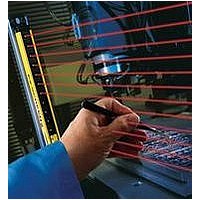QDE-825D BANNER ENGINEERING, QDE-825D Datasheet - Page 67

QDE-825D
Manufacturer Part Number
QDE-825D
Description
Safety Light Curtain
Manufacturer
BANNER ENGINEERING
Datasheet
1.QDE-815D.pdf
(74 pages)
Specifications of QDE-825D
Light Curtain Type
Safety
Accessory Type
Machine Interface Cable
For Use With
EZ-Screen Safety Light Screen
EZ-SCREEN
Instruction Manual
The following terms are used often in this manual. Where
possible, this manual uses definitions from the U.S. and
international product performance standards that govern the
design of the Safety Controller. For more definitions, visit
www.BannerEngineering.com/training/glossary.php.
ANSI (American National Standards Institute): Acronym
for the American National Standards Institute, an association
of industry representatives that develops technical standards
(including safety standards). These standards comprise a
consensus from a variety of industries on good practice and
design. ANSI standards relevant to application of safety
products include the ANSI B11 Series, and ANSI/RIA R15.06.
See “Safety Standards” on inside back cover.
Auto Power-Up: A safety light screen system feature that
enables the system to be powered up into RUN mode (or
recover from a power interruption) without requiring a manual
reset.
Blanking: A programmable feature of a safety light screen
system which allows the light screen to ignore certain objects
located within the defined area. See fixed blanking, Floating
Blanking, and Reduced Resolution.
Blocked Condition: A condition that occurs when an opaque
object of sufficient size blocks/interrupts one or more light
screen beams. When a blocked condition occurs, OSSD1
and OSSD2 outputs simultaneously turn off within the system
response time.
Brake: A mechanism for stopping, slowing, or preventing
motion.
Cascade: Series connection (or “daisy-chaining”) of multiple
emitters and receivers.
CE: Abbreviation for “Conformité Européenne” (French
translation of “European Conformity”). The CE mark on a
product or machine establishes its compliance with all relevant
European Union (EU) Directives and the associated safety
standards.
Clutch: A mechanism that, when engaged, transmits torque to
impart motion from a driving member to a driven member.
Banner Engineering Corp.
Banner Engineering Corp.
www.bannerengineering.com • Tel: 763.544.3164
www.bannerengineering.com • Tel: 763.544.3164
Glossary of Terms
•
•
Minneapolis, U.S.A.
Minneapolis, U.S.A.
Control Reliability: A method of ensuring the performance
integrity of a control system or device. Control circuits are
designed and constructed so that a single failure or fault within
the system does not prevent the normal stopping action from
being applied to the machine when required, or does not create
unintended machine action, but does prevent initiation of
successive machine action until the failure is corrected.
CSA: Abbreviation for Canadian Standards Association, a testing
agency similar to Underwriters Laboratories, Inc. (UL) in the
United States. A CSA-certified product has been type-tested and
approved by the Canadian Standards Association as meeting
electrical and safety codes.
Defined Area: The “screen of light” generated by a safety
light screen system, defined by the height and the separation
distance of the emitter and receiver. When the defined area is
interrupted by an opaque object of a specified cross section, a
Trip or Latch condition results.
Designated Person: An individual identified and designated
in writing, by the employer, as being appropriately trained and
qualified to perform a specified checkout procedure. (See
Qualified Person.)
Emitter: The light-emitting component of a safety light screen
system, consisting of a row of synchronized modulated LEDs.
The emitter, together with the receiver (placed opposite), creates
a “screen of light” called the defined area.
External Device Monitoring (EDM): A means by which a
safety device (such as a safety light screen) actively monitors
the state (or status) of external devices that may be controlled
by the safety device. A lockout of the safety device will result
if an unsafe state is detected in the external device. External
device(s) may include, but are not limited to: MPCEs, captive
contact relays/contactors, and safety modules.
Failure to Danger: A failure which delays or prevents a machine
safety system from arresting dangerous machine motion, thereby
increasing risk to personnel.
Final Switching Device (FSD): The component of the machine’s
safety-related control system that interrupts the circuit to the
machine primary control element (MPCE) when the output signal
switching device (OSSD) goes to the OFF-state.
Glossary
Overview
P/N 112852 rev. F
P/N 133487
65
65














